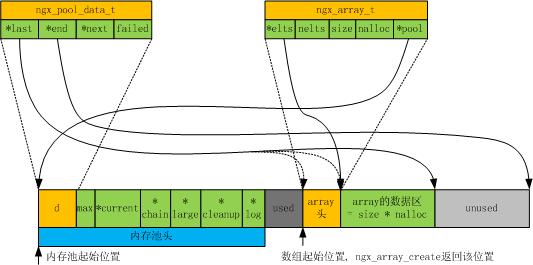nginx数组结构ngx_array_t剖析
1. 序
nginx自定义了很多数据结构,其中很多的程序都需要用到这些复杂的数据结构,如:数组,链表,红黑树等,在这里可以通过源码看每个数据结构的实现,在博客中不准备针对每个数据结构进行讲解,这里抽取ngx_array_t数组结构。
2. 数组结构
2.1 ngx_array_t结构
nginx的数组结构为ngx_array_t,定义如下。
- struct ngx_array_s {
- void *elts; //数组数据区起始位置
- ngx_uint_t nelts; //实际存放的元素个数
- size_t size; //每个元素大小
- ngx_uint_t nalloc; //数组所含空间个数,即实际分配的小空间的个数
- ngx_pool_t *pool; //该数组在此内存池中分配
- };
- typedef struct ngx_array_s ngx_array_t;
sizeof(ngx_array_t)=20。由其定义可见,nginx的数组也要从内存池中分配。将分配nalloc个大小为size的小空间,实际分配的大小为(nalloc * size)。详见下文的分析。
2.2 ngx_array_t逻辑结构

3. 数组操作
数组操作共有5个,如下。
- //创建数组
- ngx_array_t*ngx_array_create(ngx_pool_t *p, ngx_uint_t n, size_t size);
- //销毁数组
- voidngx_array_destroy(ngx_array_t *a);
- //向数组中添加元素
- void*ngx_array_push(ngx_array_t *a);
- void*ngx_array_push_n(ngx_array_t *a, ngx_uint_t n);
- //初始化数组
- staticngx_inline ngx_int_t
- ngx_array_init(ngx_array_t*array, ngx_pool_t *pool, ngx_uint_t n, size_t size)
3.1 创建数组
创建数组的操作实现如下,首先分配数组头(20B),然后分配数组数据区,两次分配均在传入的内存池(pool指向的内存池)中进行。然后简单初始化数组头并返回数组头的起始位置。
ngx_array_t*
ngx_array_create(ngx_pool_t*p, ngx_uint_t n, size_t size)
{
ngx_array_t *a;
a = ngx_palloc(p,sizeof(ngx_array_t)); //从内存池中分配数组头
if (a == NULL) {
return NULL;
}
a->elts = ngx_palloc(p,n * size); //接着分配n*size大小的区域作为数组数据区
if (a->elts == NULL) {
return NULL;
}
a->nelts = 0; //初始化
a->size = size;
a->nalloc = n;
a->pool = p;
return a; //返回数组头的起始位置
} 
3.2 销毁数组
销毁数组的操作实现如下,包括销毁数组数据区和数组头。这里的销毁动作实际上就是修改内存池的last指针,并没有调用free等释放内存的操作,显然,这种维护效率是很高的。
void
ngx_array_destroy(ngx_array_t*a)
{
ngx_pool_t *p;
p = a->pool;
if ((u_char *) a->elts+ a->size * a->nalloc == p->d.last) { //先销毁数组数据区
p->d.last -=a->size * a->nalloc; //设置内存池的last指针
}
if ((u_char *) a +sizeof(ngx_array_t) == p->d.last) { //接着销毁数组头
p->d.last = (u_char*) a; //设置内存池的last指针
}
} 3.3 添加1个元素
向数组添加元素的操作有两个,ngx_array_push和ngx_array_push_n,分别添加一个和多个元素。
但实际的添加操作并不在这两个函数中完成,例如ngx_array_push返回可以在该数组数据区中添加这个元素的位置,ngx_array_push_n则返回可以在该数组数据区中添加n个元素的起始位置,而添加操作即在获得添加位置之后进行,如后文的例子。
void *
ngx_array_push(ngx_array_t*a)
{
void *elt, *new;
size_t size;
ngx_pool_t *p;
if (a->nelts ==a->nalloc) { //数组数据区满
/* the arrayis full */
size = a->size *a->nalloc; //计算数组数据区的大小
p = a->pool;
if ((u_char *)a->elts + size == p->d.last //若内存池的last指针指向数组数据区的末尾
&&p->d.last + a->size <= p->d.end) //且内存池未使用的区域可以再分配一个size大小的小空间
{
/*
* the array allocation is the lastin the pool
* and there is space for newallocation
*/
p->d.last +=a->size; //分配一个size大小的小空间(a->size为数组一个元素的大小)
a->nalloc++; //实际分配小空间的个数加1
} else {
/* allocate a new array */
new =ngx_palloc(p, 2 * size); //否则,扩展数组数据区为原来的2倍
if (new == NULL) {
return NULL;
}
ngx_memcpy(new,a->elts, size);//将原来数据区的内容拷贝到新的数据区
a->elts = new;
a->nalloc *= 2; //注意:此处转移数据后,并未释放原来的数据区,内存池将统一释放
}
}
elt = (u_char *)a->elts + a->size * a->nelts; //数据区中实际已经存放数据的子区的末尾
a->nelts++; //即最后一个数据末尾,该指针就是下一个元素开始的位置
return elt; //返回该末尾指针,即下一个元素应该存放的位置
} 由此可见,向数组中添加元素实际上也是在修该内存池的last指针(若数组数据区满)及数组头信息,即使数组满了,需要扩展数据区内容,也只需要内存拷贝完成,并不需要数据的移动操作,这个效率也是相当高的。
下图是向数组中添加10个整型元素后的一个例子。代码可参考下文的例子。当然,数组元素也不仅限于例子的整型数据,也可以是其他类型的数据,如结构体等。

4. 一个例子
4.1 代码
/**
* ngx_array_t test, to test ngx_array_create, ngx_array_push
*/
#include <stdio.h>
#include "ngx_config.h"
#include "ngx_conf_file.h"
#include "nginx.h"
#include "ngx_core.h"
#include "ngx_string.h"
#include "ngx_palloc.h"
#include "ngx_array.h"
volatile ngx_cycle_t *ngx_cycle;
void ngx_log_error_core(ngx_uint_t level, ngx_log_t *log, ngx_err_t err,
const char *fmt, ...)
{
}
void dump_pool(ngx_pool_t* pool)
{
while (pool)
{
printf("pool = 0x%x\n", pool);
printf(" .d\n");
printf(" .last = 0x%x\n", pool->d.last);
printf(" .end = 0x%x\n", pool->d.end);
printf(" .next = 0x%x\n", pool->d.next);
printf(" .failed = %d\n", pool->d.failed);
printf(" .max = %d\n", pool->max);
printf(" .current = 0x%x\n", pool->current);
printf(" .chain = 0x%x\n", pool->chain);
printf(" .large = 0x%x\n", pool->large);
printf(" .cleanup = 0x%x\n", pool->cleanup);
printf(" .log = 0x%x\n", pool->log);
printf("available pool memory = %d\n\n", pool->d.end - pool->d.last);
pool = pool->d.next;
}
}
void dump_array(ngx_array_t* a)
{
if (a)
{
printf("array = 0x%x\n", a);
printf(" .elts = 0x%x\n", a->elts);
printf(" .nelts = %d\n", a->nelts);
printf(" .size = %d\n", a->size);
printf(" .nalloc = %d\n", a->nalloc);
printf(" .pool = 0x%x\n", a->pool);
printf("elements: ");
int *ptr = (int*)(a->elts);
for (; ptr < (int*)(a->elts + a->nalloc * a->size); )
{
printf("0x%x ", *ptr++);
}
printf("\n");
}
}
int main()
{
ngx_pool_t *pool;
int i;
printf("--------------------------------\n");
printf("create a new pool:\n");
printf("--------------------------------\n");
pool = ngx_create_pool(1024, NULL);
dump_pool(pool);
printf("--------------------------------\n");
printf("alloc an array from the pool:\n");
printf("--------------------------------\n");
ngx_array_t *a = ngx_array_create(pool, 10, sizeof(int));
dump_pool(pool);
for (i = 0; i < 10; i++)
{
int *ptr = ngx_array_push(a);
*ptr = i + 1;
}
dump_array(a);
ngx_array_destroy(a);
ngx_destroy_pool(pool);
return 0;
}
4.2 如何编译
本文编写的makefile文件如下,注意NGX_ROOT为nginx所存放的源代码路径(我的linux操作系统上的存放nginx位置为:( /home/chenglin/nginx-1.0.11 )
CXX = gcc
CXXFLAGS +=-g -Wall -Wextra
NGX_ROOT =/home/chenglin/nginx-1.0.11
TARGETS =ngx_array_t_test
TARGETS_C_FILE= $(TARGETS).c
CLEANUP = rm-f $(TARGETS) *.o
all:$(TARGETS)
clean:
$(CLEANUP)
CORE_INCS =-I. \
-I$(NGX_ROOT)/src/core \
-I$(NGX_ROOT)/src/event \
-I$(NGX_ROOT)/src/event/modules \
-I$(NGX_ROOT)/src/os/unix \
-I$(NGX_ROOT)/objs \
NGX_PALLOC =$(NGX_ROOT)/objs/src/core/ngx_palloc.o
NGX_STRING =$(NGX_ROOT)/objs/src/core/ngx_string.o
NGX_ALLOC =$(NGX_ROOT)/objs/src/os/unix/ngx_alloc.o
NGX_ARRAY =$(NGX_ROOT)/objs/src/core/ngx_array.o
$(TARGETS):$(TARGETS_C_FILE)
$(CXX) $(CXXFLAGS) $(CORE_INCS) $(NGX_PALLOC) $(NGX_STRING)$(NGX_ALLOC) $(NGX_ARRAY) $^ -o $@
4.3 运行结果
# ./ngx_array_t_test
-------------------------------- create a new pool:
-------------------------------- pool = 0x860b020 .d .last = 0x860b048
.end = 0x860b420
.next = 0x0
.failed = 0 .max = 984
.current = 0x860b020
.chain = 0x0
.large = 0x0
.cleanup = 0x0
.log = 0x0 available pool memory = 984
-------------------------------- alloc an array from the pool:
-------------------------------- pool = 0x860b020 .d .last = 0x860b084
.end = 0x860b420
.next = 0x0
.failed = 0 .max = 984
.current = 0x860b020
.chain = 0x0
.large = 0x0
.cleanup = 0x0
.log = 0x0 available pool memory = 924
array = 0x860b048 .elts = 0x860b05c
.nelts = 10
.size = 4
.nalloc = 10
.pool = 0x860b020 elements: 0x1 0x2 0x3 0x4 0x5 0x6 0x7 0x8 0x9 0xa 参考资料:








 本文详细解析了 Nginx 中 ngx_array_t 数组结构,包括其内部结构、内存分配方式以及核心操作函数的实现原理。通过具体代码示例展示了如何使用 ngx_array_t 进行数组创建、元素添加等操作。
本文详细解析了 Nginx 中 ngx_array_t 数组结构,包括其内部结构、内存分配方式以及核心操作函数的实现原理。通过具体代码示例展示了如何使用 ngx_array_t 进行数组创建、元素添加等操作。














 1万+
1万+

 被折叠的 条评论
为什么被折叠?
被折叠的 条评论
为什么被折叠?








